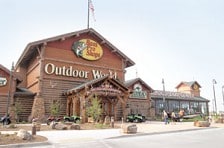Online sales pick up speed

It’s the day after Thanksgiving ¬– Black Friday, as America’s shopping fanatics call it.
Typically, this is a day when thousands of people will flock to shopping malls and other retail outlets in the wee hours of the morning, intent on finding the best deals on their holiday gifts, or even a nice post-Thanksgiving present for themselves.
More and more, though, people are taking the opportunity to sleep in, as a new trend is emerging. Holiday shoppers can make their purchases from the comfort of their homes, and judging by recent statistics, a lot of them do.
“Holiday shopping that is conducted online is growing smartly,” said David Swenson, an associate scientist in economics at Iowa State University. “That’s what people do. That is a major piece of competition for all merchants, small-town merchants and larger city merchants.”
According to statistics released by Forrester Research Inc., online retail sales went up 11 percent last year, and are forecast to go from $155 billion in 2009 to nearly $250 billion in 2014, which is projected to represent 8 percent of all retail sales.
The online-shopping craze has created an unofficial “Cyber Monday” holiday to follow Black Friday. According to digital marketing intelligence company comScore, online Cyber Monday sales reached $887 million in 2009, a number that has risen steadily every year. Online retail sales reached $29 billion during the period from Nov. 1 to Dec. 31 last year.
Those numbers don’t come close to the totals that shoppers spend in bricks-and-mortar stores during the season, but they are rising, and give retailers another way to reach out to customers.
“It helps tremendously. It makes us multifaceted in what we do,” said Larry Whiteley, manager of communications at Bass Pro Shops. “Everything we do, it complements all of it.”
Online sales seem to create a further discrepancy between large retailers, which have more resources to put into selling products through a website, and smaller retailers, which are struggling to keep up.
“The large retailers love it, because they can cross-market between their brick-and-mortar stores and their websites,” said Meghan O’Brien of O’Brien Economic Consulting in Ankeny. “It’s a little bit harder for the people who depend on foot traffic: specialty stores, small stores and stores that aren’t nationally franchised. They don’t have the advantage of stores being able to do that. They take a hit.”
Same tool, different uses
Retailers of different sizes use online commerce in different ways.
The Internet allows large retailers to complement what their stores sell, said Whiteley. Beyond that, allowing customers to shop online has become a necessity for a national retailer.
“In today’s world, you’ve almost got to,” Whiteley said.
If a customer doesn’t want to make the trip to the Bass Pro Shop in Altoona, shopping is as easy as getting on a computer.
That creates a challenge for some retailers.
In the same way a customer can buy clothing, hunting or fishing supplies online, there are numerous ways to purchase books from a website, said John Heitzman, owner of The Book Store in the Equitable Building on Locust Street. Going through an online version of Heitzman’s store isn’t one of them.
Heitzman took over ownership of the store in 1999, and has seen the Internet evolve into a marketplace.
“Without a doubt, it’s had an impact,” he said, noting that a recent survey found only 10 percent of books were purchased in traditional bookstores. “It’s daunting.”
The Book Store doesn’t have a website, and Heitzman estimates it would add a lot of work for the two-person operation to run one for just a minimal gain in sales. Instead, he relies on a base of loyal customers, who will often e-mail him the titles of books they want or bring in an Amazon.com printout.
“What I’ve found is you just have to navigate it with trying to make your store as unique as possible, carrying a unique selection of inventory … and trying to get people to want to come in, rather than just sit and shop online,” Heitzman said.
When it comes to holiday shopping, Heitzman doesn’t think the lack of a website hurts The Book Store.
“I’m thankful that I have a real loyal clientele,” he said.
At Fitness Sports in Windsor Heights, the Internet is effectively used as a tool to reach out to customers in Greater Des Moines and beyond.
Owner Steve Bobenhouse decided to start a company website in 1998, and it has turned into a moneymaker for the store. Fitness Sports specializes in running shoes, and has been able to market that to people outside Iowa through the site.
The site itself isn’t pretty, but is effective, Bobenhouse said.
“That business isn’t coming from people who could be walking in,” he said. “It’s coming from people all over the United States.”
There is no option to purchase items online, but customers can look at a wide selection of shoes and call the store to place an order, which helps Fitness Sports differentiate itself from larger companies with the same service. Salespeople can check immediately to make sure the shoe is in stock in the right size and get the order sent out that day. There aren’t multiple levels to go through, Bobenhouse said.
“What we found was the product was so specialized that people really appreciated the personalized service of talking to someone,” he said. “We really just use our regular sales staff. They know what they’re selling.”
The ‘shopping experience’
Online retailing doesn’t specifically help shopping malls, but it doesn’t necessarily hurt them either, said Joe Murdock, general manager of Merle Hay Mall.
“It’s obviously put a dent in our sales just because it’s a convenience for everyone,” he said. “I think the atmosphere here at the mall is different. That’s what we’re trying to create here, a shopping experience, not just clicking on a button.”
Steve Brower, leasing director at Jordan Creek Town Center in West Des Moines, said malls aren’t necessarily trying to compete with online shopping. People are going to do both, and that’s OK with shopping centers.
“I don’t think we specifically target what we’re going to do to compete with the online shopping,” Brower said. “I think we see that as just another alternative, and a good one for customers. Rather, we just try to make what we do a great experience.”
Brower said General Growth Properties Inc., which owns Jordan Creek, at one time tried to set up shopping options online specifically for its malls, but it didn’t work very well. Instead, it made more sense to let the stores manage their own online sales.
Retailers within the malls have embraced online holiday shopping by posting Black Friday and Cyber Monday deals on their websites.
Holiday sales projected to grow
Internet or no Internet, economists say things are going to be better this holiday season, but not a lot better.
Recent reports have indicated growth nationally. The National Retail Federation forecast holiday retail sales to reach $447.1 billion this year, up 2.3 percent from 2009. The International Council of Shopping Centers projected sales could rise as much as 3.5 percent.
Sales might be up from last year, but will be nowhere near pre-recession levels.
“The general expectation is optimistic, but not for strong growth,” said Swenson of Iowa State. “We’re doing OK in Iowa, but we’re only doing OK. There’s no indication at all that we’re improving at the kind of rate that would make people feel comfortable about letting go of the money they have.”
Reports last month indicated the recession was over. However, retail numbers are somewhat of a lagging indicator of the overall economy, consultant O’Brien said. Consumers can be told about the end of the recession, but until they feel it in their checkbooks, it doesn’t matter.
“Now we have kind of mixed messages. The recession ended; unemployment’s kind of high,” O’Brien said. “You can’t really fool the consumer. … I don’t think consumers feel that good right now.”
Greater Des Moines is in a better position going into the holiday shopping season than most of the state, O’Brien said. Employment is higher in the metropolitan area because it doesn’t rely as much on manufacturing, whereas communities that have a strong manufacturing base are seeing a more pronounced decline in retail sales.
Furthermore, because of Greater Des Moines’ size, it provides a greater number of shopping venues, drawing shoppers from well beyond the area.
For some people, holiday shopping is as much about the experience as it is the end result, which is what helps the malls and larger retail stores draw foot traffic. Bass Pro Shop, for example, has a “Santa’s Wonderland” setup with free activities for children. Though shoppers might spend less money when the economy is down, Jordan Creek mall is “always going to draw people in,” O’Brien said.
“It becomes part of the identity of Christmas shopping,” she said. “People travel there. They have lunch. They shop. They don’t want to give that up because then they really do feel poor.”
Murdock, from Merle Hay Mall, said his retailers felt “cautiously optimistic” about the holiday season, noting that one person told him things were getting “less worse.”
The overall direction of seems to be positive, but only moderately.
“Until we add jobs and more households have more income, you’re not going to have more spending,” Swenson said.










